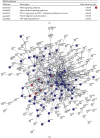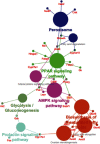Noncoding RNAs Associated with PPARs in Etiology of MAFLD as a Novel Approach for Therapeutics Targets
- PMID: 36164476
- PMCID: PMC9509273
- DOI: 10.1155/2022/6161694
Noncoding RNAs Associated with PPARs in Etiology of MAFLD as a Novel Approach for Therapeutics Targets
Abstract
Background: Metabolic associated fatty liver disease (MAFLD) is a complex disease that results from the accumulation of fat in the liver. MAFLD is directly associated with obesity, insulin resistance, diabetes, and metabolic syndrome. PPARγ ligands, including pioglitazone, are also used in the management of this disease. Noncoding RNAs play a critical role in various diseases such as diabetes, obesity, and liver diseases including MAFLD. However, there is no adequate knowledge about the translation of using these ncRNAs to the clinics, particularly in MAFLD conditions. The aim of this study was to identify ncRNAs in the etiology of MAFLD as a novel approach to the therapeutic targets.
Methods: We collected human and mouse MAFLD gene expression datasets available in GEO. We performed pathway enrichment analysis of total mRNAs based on KEGG repository data to screen the most potential pathways in the liver of MAFLD human subjects and mice model, and analyzed pathway interconnections via ClueGO. Finally, we screened disease causality of the MAFLD ncRNAs, which were associated with PPARs, and then discussed the role of revealed ncRNAs in PPAR signaling and MAFLD.
Results: We found 127 ncRNAs in MAFLD which 25 out of them were strongly validated before for regulation of PPARs. With a polypharmacology approach, we screened 51 ncRNAs which were causal to a subset of diseases related to MAFLD.
Conclusion: This study revealed a subset of ncRNAs that could help in more clear and guided designation of preclinical and clinical studies to verify the therapeutic application of the revealed ncRNAs by manipulating the PPARs molecular mechanism in MAFLD.
Copyright © 2022 Fatemeh Kazeminasab et al.
Conflict of interest statement
The authors declare that there is no conflict of interest regarding the publication of this article.
Figures






Similar articles
-
Circular RNAs, Noncoding RNAs, and N6-methyladenosine Involved in the Development of MAFLD.Noncoding RNA. 2024 Feb 5;10(1):11. doi: 10.3390/ncrna10010011. Noncoding RNA. 2024. PMID: 38392966 Free PMC article. Review.
-
Combined Analysis of Expression Profiles in a Mouse Model and Patients Identified BHMT2 as a New Regulator of Lipid Metabolism in Metabolic-Associated Fatty Liver Disease.Front Cell Dev Biol. 2021 Nov 11;9:741710. doi: 10.3389/fcell.2021.741710. eCollection 2021. Front Cell Dev Biol. 2021. PMID: 34869329 Free PMC article.
-
Tandem Mass Tag-based quantitative proteomics analysis of metabolic associated fatty liver disease induced by high fat diet in mice.Nutr Metab (Lond). 2020 Nov 18;17(1):97. doi: 10.1186/s12986-020-00522-3. Nutr Metab (Lond). 2020. PMID: 33292312 Free PMC article.
-
Assessment of mitochondrial function in metabolic dysfunction-associated fatty liver disease using obese mouse models.Zool Res. 2020 Sep 18;41(5):539-551. doi: 10.24272/j.issn.2095-8137.2020.051. Zool Res. 2020. PMID: 32786176 Free PMC article.
-
Pathophysiological Molecular Mechanisms of Obesity: A Link between MAFLD and NASH with Cardiovascular Diseases.Int J Mol Sci. 2021 Oct 27;22(21):11629. doi: 10.3390/ijms222111629. Int J Mol Sci. 2021. PMID: 34769060 Free PMC article. Review.
Cited by
-
Targeted MicroRNA Profiling Reveals That Exendin-4 Modulates the Expression of Several MicroRNAs to Reduce Steatosis in HepG2 Cells.Int J Mol Sci. 2023 Jul 18;24(14):11606. doi: 10.3390/ijms241411606. Int J Mol Sci. 2023. PMID: 37511368 Free PMC article.
-
The Loss of PPARγ Expression and Signaling Is a Key Feature of Cutaneous Actinic Disease and Squamous Cell Carcinoma: Association with Tumor Stromal Inflammation.Cells. 2024 Aug 15;13(16):1356. doi: 10.3390/cells13161356. Cells. 2024. PMID: 39195246 Free PMC article.
References
LinkOut - more resources
Full Text Sources

